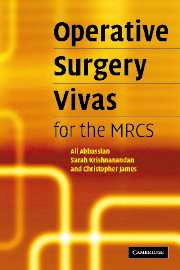Book contents
- Frontmatter
- Contents
- Preface
- 1 The elective repair of an abdominal aortic aneurysm
- 2 Adrenalectomy
- 3 Amputation (below knee)
- 4 Anorectal abscesses, fistulae and pilonidal sinus
- 5 Appendicectomy
- 6 Principles of bowel anastomosis
- 7 Breast surgery
- 8 Carotid endarterectomy
- 9 Carpal tunnel decompression
- 10 Central venous cannulation
- 11 Cholecystectomy (laparoscopic)
- 12 Circumcision
- 13 Colles' fracture (closed reduction of)
- 14 Compound fractures
- 15 Dupuytren's contracture release
- 16 Dynamic hip screw
- 17 Fasciotomy for compartment syndrome
- 18 Femoral embolectomy
- 19 Femoral hernia repair
- 20 Haemorrhoidectomy
- 21 Hip surgery
- 22 Hydrocele repair
- 23 The open repair of an inguinal hernia
- 24 Laparotomy and abdominal incisions
- 25 Oesophago-gastroduodenoscopy
- 26 Orchidectomy
- 27 Parotidectomy
- 28 Perforated peptic ulcer
- 29 Pyloric stenosis and Ramstedt's pyloromyotomy
- 30 Right hemicolectomy
- 31 Skin cover (the reconstructive ladder)
- 32 Spinal procedures
- 33 Splenectomy
- 34 Stomas
- 35 Submandibular gland excision
- 36 Tendon repairs
- 37 Thoracostomy (insertion of a chest drain)
- 38 Thoracotomy
- 39 Thyroidectomy
- 40 Tracheostomy
- 41 Urinary retention and related surgical procedures
- 42 Varicose vein surgery
- 43 Vasectomy
- 44 Zadik's procedure
4 - Anorectal abscesses, fistulae and pilonidal sinus
Published online by Cambridge University Press: 16 October 2009
- Frontmatter
- Contents
- Preface
- 1 The elective repair of an abdominal aortic aneurysm
- 2 Adrenalectomy
- 3 Amputation (below knee)
- 4 Anorectal abscesses, fistulae and pilonidal sinus
- 5 Appendicectomy
- 6 Principles of bowel anastomosis
- 7 Breast surgery
- 8 Carotid endarterectomy
- 9 Carpal tunnel decompression
- 10 Central venous cannulation
- 11 Cholecystectomy (laparoscopic)
- 12 Circumcision
- 13 Colles' fracture (closed reduction of)
- 14 Compound fractures
- 15 Dupuytren's contracture release
- 16 Dynamic hip screw
- 17 Fasciotomy for compartment syndrome
- 18 Femoral embolectomy
- 19 Femoral hernia repair
- 20 Haemorrhoidectomy
- 21 Hip surgery
- 22 Hydrocele repair
- 23 The open repair of an inguinal hernia
- 24 Laparotomy and abdominal incisions
- 25 Oesophago-gastroduodenoscopy
- 26 Orchidectomy
- 27 Parotidectomy
- 28 Perforated peptic ulcer
- 29 Pyloric stenosis and Ramstedt's pyloromyotomy
- 30 Right hemicolectomy
- 31 Skin cover (the reconstructive ladder)
- 32 Spinal procedures
- 33 Splenectomy
- 34 Stomas
- 35 Submandibular gland excision
- 36 Tendon repairs
- 37 Thoracostomy (insertion of a chest drain)
- 38 Thoracotomy
- 39 Thyroidectomy
- 40 Tracheostomy
- 41 Urinary retention and related surgical procedures
- 42 Varicose vein surgery
- 43 Vasectomy
- 44 Zadik's procedure
Summary
Where do anorectal abscesses occur?
These abscess are usually caused by an infection in one of the anal glands in the intersphincteric space. As the infection worsens, there is the spread of pus, which may track to the skin causing a perianal abscess (most common), laterally through puborectalis causing an ischiorectal abscess, or more internally causing a supralevator abscess.
What are other causes of anorectal abscess?
Those not related to the anal glands and these are:
Submucosal abscess from infected haemorrhoids or fissures
Subcutaneous from an infected hair follicle
What is the usual organism responsible?
Gram-positive Staphylococcus aureus is the most common organism although occasionally bowel flora will cause an infection. If bowel flora is present there is a higher proportion of associated fistulae.
What is the surgical treatment?
Incision and drainage of the abscess under general anaesthetic is the treatment of choice.
How would you perform an incision and drainage of an anorectal abscess?
Pre-operatively The patient should be appropriately consented. There is no specific requirement for antibiotics unless the patient has cellulitis or is immunocompromised.
Position This is supine and in the lithotomy position. Rectal examination is then performed (proctoscopy/sigmoidoscopy) to search for an internal discharge or fistula opening (it is important not to probe in this acute setting as there is a risk of forming a fistula).
Incision A cruciate incision is made over the abscess at the point of maximal fluctuance.
Procedure A pus swab taken and sent for microscopy and sensitivities. The pus is drained out and loculations are broken down with a finger. Curettage is then performed to the wall of the abscess and any necrotic tissue is excised.
- Type
- Chapter
- Information
- Operative Surgery Vivas for the MRCS , pp. 13 - 16Publisher: Cambridge University PressPrint publication year: 2006



